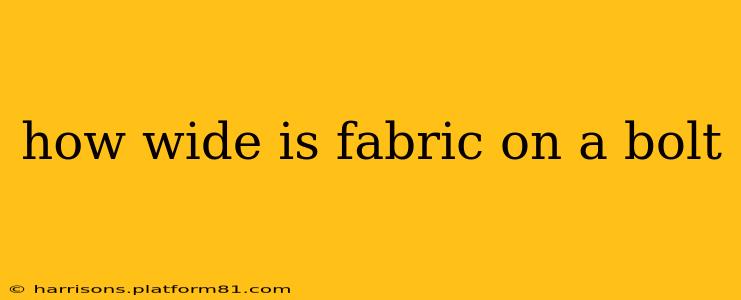Choosing the right fabric for your next project requires understanding more than just the material itself. Knowing the width of fabric on a bolt is crucial for accurate estimations of yardage and efficient project planning. This guide will delve into the common widths, variations, and factors influencing fabric bolt size.
What are the standard fabric bolt widths?
The standard width of fabric on a bolt varies depending on the type of fabric and its manufacturing process. However, you'll commonly encounter these widths:
-
43-45 inches (109-114 cm): This is a very common width for many woven fabrics, including cotton, linen, and quilting cotton. It's a versatile width suitable for a wide range of projects.
-
54-60 inches (137-152 cm): Wider fabrics like double-width quilting cotton, broadcloth, and some upholstery fabrics fall into this range. This wider width can reduce the number of seams needed in larger projects.
-
Other widths: You might also encounter fabrics in other widths, particularly with specialty fabrics or those from smaller manufacturers. Always check the listing or contact the seller to confirm the width.
Why does fabric width vary?
Several factors contribute to the variation in fabric bolt widths:
-
Weaving process: The loom's width directly influences the fabric's width. Different loom sizes are used to produce fabrics of varying widths.
-
Fabric type: Some fabrics, by their nature, are produced in narrower or wider widths than others. For instance, certain silks or specialty wovens might have limited width options.
-
Manufacturer: Different manufacturers might use different loom sizes or processes, resulting in slight variations in fabric width.
How does fabric width affect my project?
Understanding fabric width is critical for successful sewing and crafting:
-
Yardage calculations: Knowing the width allows you to accurately calculate how much fabric you need to avoid running short. Wider fabrics often reduce the amount of fabric needed because fewer seams are required.
-
Pattern layout: Pattern pieces need to fit within the fabric's width. A narrower width might require more careful planning and potentially more fabric to accommodate pattern placement.
-
Seams: Wider fabrics mean fewer seams, which can lead to a cleaner, more professional finish, particularly in larger garments or projects.
What if I need a specific width?
If you require a specific fabric width for your project, it's best to:
-
Check the listing: Online retailers and fabric stores usually specify the width in their product descriptions.
-
Contact the seller: If the width isn't clear, contact the seller directly to confirm the fabric's width before purchasing.
-
Consider alternatives: If you can't find a fabric in the desired width, consider adjusting your project design or exploring alternative fabrics with suitable widths.
Does the fabric width affect the price?
Generally, wider fabrics are more expensive per yard than narrower fabrics. This is because more raw materials are used to produce a single yard of wider fabric.
What about knit fabrics? Width considerations for knits?
Knit fabrics also come in varying widths, often similar to woven fabrics. However, the stretch and drape of knit fabrics can slightly affect how you use the width in your project planning. Always check the listing for specific width information.
This guide aims to clarify the common widths and variations of fabric on a bolt, providing essential information for all sewing and crafting enthusiasts. Remember to always confirm the fabric width before purchasing to ensure a successful project.
